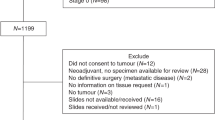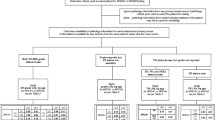Abstract
Glycodelin (encoded by PAEP gene) is a secreted lipocalin protein mainly expressed in reproductive tissues, but also in several tumour types. In the breast, glycodelin is expressed both in normal epithelial and cancerous tissue. To investigate the association of glycodelin with clinicopathological features of breast cancer and outcome of patients we evaluated the protein expression of glycodelin in a large series of breast tumours. Immunohistochemical analysis of tissue microarrays was used to study glycodelin expression on 399 sporadic and 436 familial non-BRCA1/2 tumours with strong family history. Gene expression analysis was used to define genes co-expressed with PAEP in sporadic and familial non-BRCA1/2 breast tumours. In the sporadic series, the glycodelin expression associated with low proliferation rate (P < 0.001), with a tendency towards well-differentiated tumours (grades 1 and 2, P = 0.012) and high cyclin D1 (P = 0.034) expression. However, in familial non-BRCA1/2 cases with strong family history glycodelin expression associated with a less favourable phenotype, i.e. positive lymph node status (P = 0.003) and HER2-positive tumours (P = 0.009). Moreover, the patients with glycodelin-positive tumours had an increased risk for distant metastases (P = 0.001) and in multivariate analysis glycodelin expression was an independent predictor of metastasis (hazard ratio (HR) = 2.22, 95% confidence interval (95% CI) = 1.22–4.03, P = 0.009) in familial non-BRCA1/2 breast cancer. Gene expression analysis further revealed different gene expression profiles correlating with the PAEP expression in the sporadic and familial non-BRCA1/2 breast cancers. Our findings suggest differential progression pathways in the sporadic and familial non-BRCA1/2 breast tumours expressing glycodelin.

Similar content being viewed by others
References
Seppälä M, Taylor RN, Koistinen H et al (2002) Glycodelin: a major lipocalin protein of the reproductive axis with diverse actions in cell recognition and differentiation. Endocr Rev 23:401–430
Morris HR, Dell A, Easton RL et al (1996) Gender-specific glycosylation of human glycodelin affects its contraceptive activity. J Biol Chem 271:32159–32167
Yeung WS, Lee KF, Koistinen R et al (2009) Effects of glycodelins on functional competence of spermatozoa. J Reprod Immunol 83:26–30
Alok A, Karande AA (2009) The role of glycodelin as an immune-modulating agent at the feto-maternal interface. J Reprod Immunol 83:124–127
Seppälä M, Koistinen H, Koistinen R et al (2009) Glycodelin in reproductive endocrinology and hormone-related cancer. Eur J Endocrinol 160:121–133
Kamäräinen M, Seppälä M, Virtanen I et al (1997) Expression of glycodelin in MCF-7 breast cancer cells induces differentiation into organized acinar epithelium. Lab Invest 77:565–573
Hautala LC, Koistinen R, Seppälä M et al (2008) Glycodelin reduces breast cancer xenograft growth in vivo. Int J Cancer 123:2279–2284
Koistinen H, Seppälä M, Nagy B et al (2005) Glycodelin reduces carcinoma-associated gene expression in endometrial adenocarcinoma cells. Am J Obstet Gynecol 193:1955–1960
Uchida H, Maruyama T, Nagashima T et al (2005) Histone deacetylase inhibitors induce differentiation of human endometrial adenocarcinoma cells through up-regulation of glycodelin. Endocrinology 146:5365–5373
Ohta K, Maruyama T, Uchida H et al (2008) Glycodelin blocks progression to S phase and inhibits cell growth: a possible progesterone-induced regulator for endometrial epithelial cell growth gycodelin inhibits G1/S progression. Mol Hum Reprod 14:17–22
Koistinen H, Hautala LC, Seppälä M et al (2009) The role of glycodelin in cell differentiation and tumor growth. Scand J Clin Lab Invest 69:452–459
Mandelin E, Lassus H, Seppälä M et al (2003) Glycodelin in ovarian serous carcinoma: association with differentiation and survival. Cancer Res 63:6258–6264
Kämäräinen M, Halttunen M, Koistinen R et al (1999) Expression of glycodelin in human breast and breast cancer. Int J Cancer 83:738–742
Jeschke U, Mylonas I, Kunert-Keil C et al (2005) Expression of glycodelin protein and mRNA in human ductal breast cancer carcinoma in situ, invasive ductal carcinomas, their lymph node and distant metastases, and ductal carcinomas with recurrence. Oncol Rep 13:413–419
Scholz C, Toth B, Barthell E et al (2009) Immunohistochemical expression of glycodelin in breast cancer correlates with estrogen-receptor alpha and progesterone-receptor A positivity. Histol Histopathol 24:467–471
Syrjäkoski K, Vahteristo P, Eerola H et al (2000) Population-based study of BRCA1 and BRCA2 mutations in 1035 unselected Finnish breast cancer patients. J Natl Cancer Inst 92:1529–1531
Kilpivaara O, Bartkova J, Eerola H et al (2005) Correlation of CHEK2 protein expression and c.1100delC mutation status with tumor characteristics among unselected breast cancer patients. Int J Cancer 113:575–580
Eerola H, Blomqvist C, Pukkala E et al (2000) Familial breast cancer in southern Finland: how prevalent are breast cancer families and can we trust the family history reported by patients? Eur J Cancer 36:1143–1148
Vehmanen P, Friedman LS, Eerola H et al (1997) Low proportion of BRCA1 and BRCA2 mutations in Finnish breast cancer families: evidence for additional susceptibility genes. Hum Mol Genet 6:2309–2315
Vahteristo P, Eerola H, Tamminen A et al (2001) A probability model for predicting BRCA1 and BRCA2 mutations in breast and breast-ovarian cancer families. Br J Cancer 84:704–708
Vahteristo P, Bartkova J, Eerola H et al (2002) A CHEK2 genetic variant contributing to a substantial fraction of familial breast cancer. Am J Hum Genet 71:432–438
Elston CW, Ellis IO (1991) Pathological prognostic factors in breast cancer. I. The value of histological grade in breast cancer: experience from a large study with long-term follow-up. Histopathology 19:403–410
Tommiska J, Eerola H, Heinonen M et al (2005) Breast cancer patients with p53 Pro72 homozygous genotype have a poorer survival. Clin Cancer Res 11:5098–5103
Aaltonen K, Blomqvist C, Amini RM et al (2008) Familial breast cancers without mutations in BRCA1 or BRCA2 have low cyclin E and high cyclin D1 in contrast to cancers in BRCA mutation carriers. Clin Cancer Res 14:1976–1983
Ahlin C, Aaltonen K, Amini RM et al (2007) Ki67 and cyclin A as prognostic factors in early breast cancer. What are the optimal cut-off values? Histopathology 51:491–498
Heikkinen T, Kärkkäinen H, Aaltonen K et al (2009) The breast cancer susceptibility mutation PALB2 1592delT is associated with an aggressive tumor phenotype. Clin Cancer Res 15:3214–3222
Blows FM, Driver KE, Schmidt MK et al (2010) Subtyping of breast cancer by immunohistochemistry to investigate a relationship between subtype and short and long term survival: a collaborative analysis of data for 10,159 cases from 12 studies. PLoS Med 7:e1000279
McShane LM, Altman DG, Sauerbrei W et al (2005) Reporting recommendations for tumor marker prognostic studies. J Clin Oncol 23:9067–9072
Eerola H, Heikkilä P, Tamminen A et al (2005) Relationship of patients’ age to histopathological features of breast tumours in BRCA1 and BRCA2 and mutation-negative breast cancer families. Breast Cancer Res 7:R465–R469
Gentleman RC, Carey VJ, Bates DM et al (2004) Bioconductor: open software development for computational biology and bioinformatics. Genome Biol 5:R80
Du P, Kibbe WA, Lin SM (2008) Lumi: a pipeline for processing Illumina microarray. Bioinformatics 24:1547–1548
Bolstad BM, Irizarry RA, Astrand M et al (2003) A comparison of normalization methods for high density oligonucleotide array data based on variance and bias. Bioinformatics 19:185–193
Tatusova T (2010) Genomic databases and resources at the national center for biotechnology information. Methods Mol Biol 609:17–44
Huang DW, Sherman BT, Lempicki RA (2009) Systematic and integrative analysis of large gene lists using DAVID bioinformatics resources. Nat Protoc 4:44–57
Aaltonen K, Amini RM, Landberg G et al (2009) Cyclin D1 expression is associated with poor prognostic features in estrogen receptor positive breast cancer. Breast Cancer Res Treat 113:75–82
Ren S, Liu S, Howell PM Jr et al (2009) Functional characterization of the progestagen-associated endometrial protein gene in human melanoma. J Cell Mol Med. doi:10.1111/j.1582-4934.2009.00922.x
Palacios J, Robles-Frias MJ, Castilla MA et al (2008) The molecular pathology of hereditary breast cancer. Pathobiology 75:85–94
Melchor L, Benitez J (2008) An integrative hypothesis about the origin and development of sporadic and familial breast cancer subtypes. Carcinogenesis 29:1475–1482
Waddell N, Arnold J, Cocciardi S et al (2009) Subtypes of familial breast tumours revealed by expression and copy number profiling. Breast Cancer Res Treat. doi:10.1007/s10549-009-0653-1
Fletcher O, Houlston RS (2010) Architecture of inherited susceptibility to common cancer. Nat Rev Cancer 10:353–361
Meindl A, Hellebrand H, Wiek C et al (2010) Germline mutations in breast and ovarian cancer pedigrees establish RAD51C as a human cancer susceptibility gene. Nat Genet 42:410–414
Acknowledgments
We thank Drs. Kirsimari Aaltonen and Karl von Smitten and RN Hanna Jäntti for their help with the patient data and specimens. The Finnish Cancer Registry is gratefully acknowledged for the cancer data. This work was supported by Helsinki University Central Hospital Research Fund, Academy of Finland (132473, 135937), the Finnish Cancer Society, the Sigrid Juselius Foundation and Magnus Ehrnrooth Foundation.
Conflict of interest
None.
Author information
Authors and Affiliations
Corresponding author
Electronic supplementary material
Below is the link to the electronic supplementary material.
Rights and permissions
About this article
Cite this article
Hautala, L.C., Greco, D., Koistinen, R. et al. Glycodelin expression associates with differential tumour phenotype and outcome in sporadic and familial non-BRCA1/2 breast cancer patients. Breast Cancer Res Treat 128, 85–95 (2011). https://doi.org/10.1007/s10549-010-1065-y
Received:
Accepted:
Published:
Issue Date:
DOI: https://doi.org/10.1007/s10549-010-1065-y




